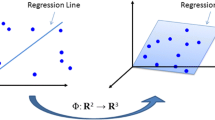Abstract
Along with the rapid development of computer and image processing technology, it is definitely convenient to obtain various images for subjects, which can be more robust to classification as more feature information is contained. However, how to effectively exploit the rich discriminative information within image sets is the key problem. In this paper, based on the concept of dual linear regression classification method for image set classification, we propose a novel discriminative framework to exploit the superiority of discriminant regression mechanism. We aim to learn a projection matrix to force the represented image points from the same class to be close and those from different class are better separated. The feature extraction strategy in our discriminative framework can appropriately work with the corresponding classification strategy, thus, better classification performance can be achieved. Moreover, we propose a kernel discriminative extension method to address the non-linearity problem by adopting the kernel trick. From the experimental results, our proposed method can obtain competitive recognition rates on face recognition tasks via mapping the original image sets into a more discriminative feature space. Besides, it also shows the effectiveness for object classification task with small image sizes and different number of frames.





Similar content being viewed by others
References
Arandjelovic O, Shakhnarovich G, Fisher J, Cipolla R, Darrell T (2005) Face recognition with image sets using manifold density divergence. In: IEEE Computer Society conference on Computer Vision and Pattern Recognition. CVPR 2005, vol 1. IEEE, pp 581–588
Boiman O, Shechtman E, Irani M (2008) In defense of nearest-neighbor based image classification. In: IEEE conference on Computer Vision and Pattern Recognition. CVPR 2008. IEEE, pp 1–8
Cevikalp H, Triggs B (2010) Face recognition based on image sets. In: 2010 IEEE conference on Computer Vision and Pattern Recognition (CVPR). IEEE, pp 2567–2573
Chai X, Shan S, Chen X, Gao W (2007) Locally linear regression for pose-invariant face recognition. IEEE Trans Image Process 16(7):1716–1725
Chen L (2014) Dual linear regression based classification for face cluster recognition. In: Proceedings of the IEEE conference on Computer Vision and Pattern Recognition, pp 2673–2680
Chen SB, Ding CH, Luo B (2014) Extended linear regression for undersampled face recognition. J Vis Commun Image Represent 25(7):1800–1809
Crammer K, Gilad-Bachrach R, Navot A, Tishby N (2003) Margin analysis of the LVQ algorithm. In: Advances in neural information processing systems, pp 479–486
Crisp DJ, Burges CJ (2000) A geometric interpretation of v-SVM classifiers. In: Advances in neural information processing systems, pp 244–250
Fan W, Yeung DY (2006) Locally linear models on face appearance manifolds with application to dual-subspace based classification. In: 2006 IEEE Computer Society conference on Computer Vision and Pattern Recognition, vol 2. IEEE, pp 1384–1390
Feng Q, Zhou Y, Lan R (2016) Pairwise linear regression classification for image set retrieval. In: Proceedings of the IEEE conference on Computer Vision and Pattern Recognition, pp 4865–4872
Gilad-Bachrach R, Navot A, Tishby N (2004) Margin based feature selection-theory and algorithms. In: Proceedings of the twenty-first international conference on Machine learning. ACM, p 43
Gross R, Shi J (2001) The cmu motion of body (mobo) database
Hamm J, Lee DD (2008) Grassmann discriminant analysis: a unifying view on subspace-based learning. In: Proceedings of the 25th international conference on Machine learning. ACM, pp 376–383
Hassanpour N, Chen L (2017) A quantum probability inspired framework for image-set based face identification. In: 2017 12th IEEE international conference on Automatic Face & Gesture Recognition (FG 2017). IEEE, pp 551–557
Hel-Or Y, Hel-Or H, David E (2014) Matching by tone mapping: photometric invariant template matching. IEEE Trans Pattern Anal Mach Intell 36(2):317–330
Hotelling H (1936) Relations between two sets of variates. Biometrika 28(3/4):321–377
Hu Y, Mian AS, Owens R (2011) Sparse approximated nearest points for image set classification. In: 2011 IEEE conference on Computer vision and pattern recognition (CVPR). IEEE, pp 121–128
Huang L, Lu J, Tan YP (2014) Multi-manifold metric learning for face recognition based on image sets. J Vis Commun Image Represent 25(7):1774–1783
Huang P, Gao G, Qian C, Yang G, Yang Z (2017) Fuzzy linear regression discriminant projection for face recognition. IEEE Access 5:4340–4349
Huang P, Lai Z, Gao G, Yang G, Yang Z (2016) Adaptive linear discriminant regression classification for face recognition. Digit Signal Proc 55:78–84
Huang SM, Yang JF (2013) Linear discriminant regression classification for face recognition. IEEE Signal Process Lett 20(1):91–94
Jin T, Liu Z, Yu Z, Min X, Li L (2017) Locality preserving collaborative representation for face recognition. Neural Process Lett 45(3):967–979
Kim M, Kumar S, Pavlovic V, Rowley H (2008) Face tracking and recognition with visual constraints in real-world videos. In: IEEE conference on Computer Vision and Pattern Recognition. CVPR 2008. IEEE, pp 1–8
Kim TK, Arandjelović O, Cipolla R (2007) Boosted manifold principal angles for image set-based recognition. Pattern Recognit 40(9):2475–2484
Kim TK, Kittler J, Cipolla R (2006) Incremental learning of locally orthogonal subspaces for set-based object recognition. In: BMVC, pp 559–568
Kim TK, Kittler J, Cipolla R (2007) Discriminative learning and recognition of image set classes using canonical correlations. IEEE Trans Pattern Anal Mach Intell 29(6):1005–1018
Kovacs G (2018) Matching by monotonic tone mapping. IEEE Trans Pattern Anal Mach Intell 40(6):1424–1436
Kovács G, Hajdu A (2013) Translation invariance in the polynomial kernel space and its applications in knn classification. Neural Process Lett 37(2):207–233
Lee KC, Ho J, Yang MH, Kriegman D (2003) Video-based face recognition using probabilistic appearance manifolds. In: 2003 IEEE Computer Society conference on Computer Vision and Pattern Recognition. Proceedings, vol 1. IEEE, pp 313–320
Li X, Fukui K, Zheng N (2009) Boosting constrained mutual subspace method for robust image-set based object recognition. In: IJCAI, pp 1132–1137
Liu Z, Qiu Y, Peng Y, Pu J, Zhang X (2017) Quaternion based maximum margin criterion method for color face recognition. Neural Process Lett 45(3):913–923
Lu J, Wang G, Moulin P (2016) Localized multifeature metric learning for image-set-based face recognition. IEEE Trans Circuits Syst Video Technol 26(3):529–540
Naseem I, Togneri R, Bennamoun M (2010) Linear regression for face recognition. IEEE Trans Pattern Anal Mach Intell 32(11):2106–2112
Nishiyama M, Yamaguchi O, Fukui K (2005) Face recognition with the multiple constrained mutual subspace method. In: International conference on audio-and video-based biometric person authentication. Springer, pp 71–80
OJE E (1983) Subspace methods of pattern recognition. In: Pattern recognition and image processing series, vol 6. Research Studies Press
Shah SAA, Nadeem U, Bennamoun M, Sohel F, Togneri R (2017) Efficient image set classification using linear regression based image reconstruction. arXiv preprint arXiv:1701.02485
Shakhnarovich G, Fisher JW, Darrell T (2002) Face recognition from long-term observations. In: European Conference on Computer Vision. Springer, pp 851–865
Shang F, Jiao L, Liu Y (2012) Integrating spectral kernel learning and constraints in semi-supervised classification. Neural Process Lett 36(2):101–115
Shu X, Gao Y, Lu H (2012) Efficient linear discriminant analysis with locality preserving for face recognition. Pattern Recognit 45(5):1892–1898
Smucler E, Yohai VJ (2017) Robust and sparse estimators for linear regression models. Comput Stat Data Anal 111:116–130
Song K, Nie F, Han J, Li X (2017) Parameter free large margin nearest neighbor for distance metric learning. In: Thirty-First AAAI conference on artificial intelligence
Tan H, Gao Y (2017) Patch-based principal covariance discriminative learning for image set classification. IEEE Access 5:15001–15012
Viola P, Jones MJ (2004) Robust real-time face detection. Int J Comput Vis 57(2):137–154
Wang B, Li W, Li Z, Liao Q (2013) Adaptive linear regression for single-sample face recognition. Neurocomputing 115:186–191
Wang R, Chen X (2009) Manifold discriminant analysis. In: IEEE conference on Computer Vision and Pattern Recognition. CVPR 2009. IEEE, pp 429–436
Wang R, Shan S, Chen X, Gao W (2008) Manifold-manifold distance with application to face recognition based on image set. In: IEEE conference on Computer Vision and Pattern Recognition. CVPR 2008. IEEE, pp 1–8
Wang W, Wang R, Shan S, Chen X (2017) Prototype discriminative learning for face image set classification. IEEE Signal Process Lett 24(9):1318–1322
Wu Y, Minoh M, Mukunoki M (2013) Collaboratively regularized nearest points for set based recognition. In: BMVC, vol 2, p 5
Yamaguchi O, Fukui K, Maeda K (1998) Face recognition using temporal image sequence. In: Third IEEE international conference on automatic face and gesture recognition. Proceedings. IEEE, pp 318–323
Yang J, Chu D, Zhang L, Xu Y, Yang J (2013) Sparse representation classifier steered discriminative projection with applications to face recognition. IEEE Trans Neural Netw Learn Syst 24(7):1023–1035
Yang M, Wang X, Liu W, Shen L (2017) Joint regularized nearest points for image set based face recognition. Image Vis Comput 58:47–60
Yang M, Zhu P, Van Gool L, Zhang L (2013) Face recognition based on regularized nearest points between image sets. In: 2013 10th IEEE international conference and workshops on automatic face and gesture recognition (FG). IEEE, pp 1–7
Zhao C, Miao D, Lai Z, Gao C, Liu C, Yang J (2013) Two-dimensional color uncorrelated discriminant analysis for face recognition. Neurocomputing 113:251–261
Zhao W, Chellappa R, Phillips PJ, Rosenfeld A (2003) Face recognition: a literature survey. ACM computing surveys (CSUR) 35(4):399–458
Zheng H, Xie J, Jin Z (2012) Heteroscedastic sparse representation based classification for face recognition. Neural Process Lett 35(3):233–244
ZhongQiu Z, ShouTao X, Dian L, WeiDon T, ZhiDa J (2019) A review of image set classification. Neurocomputing 335(28):251–260
Zhou D, Yang D, Zhang X, Huang S, Feng S (2018) Discriminative probabilistic latent semantic analysis with application to single sample face recognition. Neural Process Lett 49:1273–1298
Zhou S, Wang J, Shi R, Hou Q, Gong Y, Zheng N (2018) Large margin learning in set-to-set similarity comparison for person reidentification. IEEE Trans Multimed 20(3):593–604
Zhu P, Zhang L, Zuo W, Zhang D (2013) From point to set: extend the learning of distance metrics. In: 2013 IEEE international conference on Computer Vision (ICCV). IEEE, pp 2664–2671
Acknowledgements
This work was supported by the National Natural Science Foundation of China (Project Nos. 61673220 and 61772272).
Author information
Authors and Affiliations
Corresponding author
Additional information
Publisher's Note
Springer Nature remains neutral with regard to jurisdictional claims in published maps and institutional affiliations.
Rights and permissions
About this article
Cite this article
Yan, W., Sun, H., Sun, Q. et al. Image Set-Oriented Dual Linear Discriminant Regression Classification and Its Kernel Extension. Neural Process Lett 51, 1061–1079 (2020). https://doi.org/10.1007/s11063-019-10133-6
Published:
Issue Date:
DOI: https://doi.org/10.1007/s11063-019-10133-6




